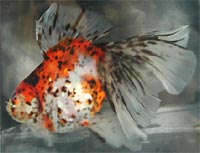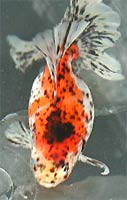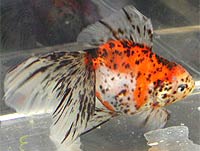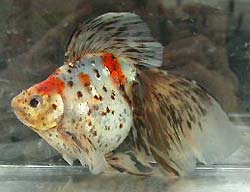VEILTAIL
The veiltail is one of the hardest fancy goldfish to breed true to type, and it is very difficult to produce good quality specimens conforming to the standard in all respects. However, it is one of the most graceful and ornamental fish and is deservedly popular amongst breeders.
This is the NO FRAMES version of the Veiltail page for small-screen computers.
THE STANDARD
The veiltail standard is as follows:
- Depth of body to be greater than 2/3rds of body length
- Dorsal fin to be single, all other fins to be paired, caudal fin to be divided
- Minimum length of caudal fin to be 3/4 of body length
- Trailing edge of caudal fin to have no apparent fork or pointed lobes
- Minimum length of body to be 5.5 cm (2¼ inches)
The fish should be bright and alert, with a short, rounded body with a smooth outline. The dorsal fin should be carried high and erect, and the caudal fin should be well divided and flowing gracefully. Good quality fish will have high colour intensity extending into the fins.
The colour may be metallic (self-coloured or variegated) or calico.
Ideal profiles are illustrated below:
 |
 |
[Top]
THE FISH
Juveniles at 7 months, calico colouration
 |
The two nearer fish possess a 'broad brush' calico patternation and have a dusky overwash of black. The fish to the rear has a more speckled pattern. All display a violet background colour.
Young adult, calico colouration
 |
 |
 |
This individual could ideally possess a taller, straighter dorsal fin but otherwise conforms to the standard well.
Mature adult, calico colouration
 |
This fish is showing some ryukin characters (a slightly indented forward dorsal contour and a slightly pointed head). As often occurs with mature fish, the dorsal leans over somewhat to one side. See Further Images for another view of this individual.
Young adult, red and silver colouration
 |
 |
 |
A particularly fine fish, which will acquire the fuller body and heavier tail with age. Good self-coloured metallic veiltails are extremely rare.
[Top]
BREEDERS' NOTES
The calico veiltail is the main form bred by BAS members, some of whom have been developing strains for 30 years. In the late 1960s and early 1970s it was difficult to acquire good starting stock as high quality veiltails were rare (and they are not so common now, either).
One breeder started with two female veiltails and two male fantails, as male veiltails were unavailable. In the first four years only 8 youngsters resembled any sort of veiltail, having short, rather forked tails and short dorsals. Over the next few years the best male offspring were paired with the original veiltail females and gradually the fish acquired the desired veiltail characters. Colour all along was good. Finally, after some ten years, the fish were placed on the show bench and indeed won some prizes, thus confirming that the right approach was being taken. This strain has gone on to win regular prizes when shown, and this account well demonstrates the extraordinary genetic potential of the goldfish for morphological variation: over ten years, the phenotype (morphological form) was shifted from a fantail-veiltail cross to almost pure veiltail.
Some breeders stick to their own strains and have had unhappy experiences with outcrossing; others swap fish amongst themselves sometimes, always being wary of introducing any unwanted characters (for example, the ryukin dorsal contour and head shape - see Other Varieties), and have outcrossed successfully. All line breeding necessarily involves inbreeding, and disturbing a gene pool that gives healthy fish to Show standard can perhaps destroy years of work if not carefully controlled and undertaken on an initially experimental basis.
Typically about 20 adults are kept for breeding, either an equal balance of the sexes or slightly more males. Veiltails are less hardy than other types (on account of their deep bodies and large finnage area) and need gradual temperature changes, so the breeding season starts in the fish house very much under the owner's control. Over the winter, the fish houses remain at slightly above the outside temperature (which is mild in this part of the world) without any heating.
In early March, temperatures are gradually turned up to about 50°F and the tanks are cleaned and the fish are fed to condition them for breeding, the feed being a range of dry foods (flake and pellets) and fresh or frozen meats (earthworms and bloodworms).
Some owners rid the fish of parasites acquired over the winter by immersion in a disinfectant bath (5 mils of Dettol to 4 Imperial gallons of water) for 30 seconds followed by a few hours in a tank of slightly salted water - this apparently drastic treatment is amazingly effective at removing parasites and leaving stock clean and healthy for breeding, but, if you are new to goldfish keeping, take advice from experienced club members before undertaking such disinfection procedures.
Temperatures are gradually raised over the next few weeks to about 65°F and the fish come into breeding condition: the females fatten with eggs and the males develop sex tubercles on the gill plates and the leading edge of the pectoral fins - the sexes are usually separated at the start of the season to control pairings. Tank temperatures should be no higher than 65°F in order not to reduce the dissolved oxygen content of the water.
Some leave selected pairs to spawn naturally, others hand-strip selected fish, a procedure which can get round any shortage of tank space to leave individual pairs on their own. Often, two or three males are put in with one female, which seems to increase the number and quantity of fertilized eggs; hence the slightly higher number of males kept by some owners. The fish spawn on fresh, clean aquatic plants in the tanks; the plant is then removed to clean tanks and the temperature raised to about 70°F; the eggs hatch after about five or six days.
After the first twenty four hours living off their yolk sacs, fry are fed infusoria, either prepared at home or purchased (eg LiquiFry), for about three days. Thereafter they are fed finely ground flake and small live foods like brine shrimp and small daphnia. Throughout this period, there is a constant danger of pollution from overfeeding; there is also the danger (usually the lesser of the two) of underfeeding very small fry and stunting their initial growth.
After about three weeks the fry are rehoused in fresh, clean tanks and larger grades of food are fed, always taking care not to pollute the water.
The first cull is carried out at between 6 to 8 weeks, depending upon development. Calico fish colour up sooner than metallics, so the process can start a little earlier with these. Fish with single tails and anal fins, undivided tails, deformities, black irises and other unwanted characters are removed.
Thereafter, culling is progressive, selecting for the fish with the best veiltail characters. Good colour, finnage and body shape are equally demanding to achieve; more often than not, a fish will be near-perfect in every respect save one, eg a single anal or curled pectoral fins. Although frustrating, one can breed from such fish with care.
By this time the ambient temperature has risen enough for the heating to be gradually reduced until the tanks reach normal water temperature for the time of year, although in some years the fish houses have to remain heated until mid June.
From a spawning of 20,000 about 10 very good adults will be achieved, giving a ratio of 2,000:1; compared with other goldfish types, the veiltail is one of the most difficult to breed to a high standard, but remains very popular and a number of breeders progress to it after success with other types such as the fantail.
Veiltails live for up to 10 years, but are not usually used for breeding
beyond the age of five. As already indicated, they are not as hardy as
other types and, although they can be kept in ponds, most members keep
them indoors or in fish houses in tanks or vats.
FURTHER IMAGES
For the Further Images page, click here.
© Bristol Aquarists' Society